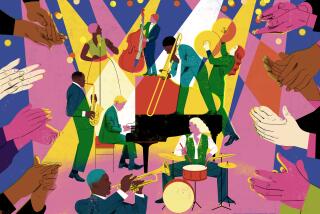Jazz Reviews : Hensen-Conant Plays a Spirited and Bluesy Harp
- Share via
The word most often used to describe the sound of the harp is celestial. But Deborah Hensen-Conant pulled a bit of the devil from the instrument Sunday night at Le Cafe as she worked through a program of jazz and blues-oriented originals.
Backed by bassist Tom Azarello and drummer Jim McMahon, Hensen-Conant overcame the apparent limitations of the harp when applied to a jazz setting; namely, the overlapping of its resonant tones during scalar runs and the delicacy of its sound. Without depending heavily on whirling glissandos and the embellishments often associated with the instrument, the harpist showed she was capable of executing involved, uptempo melodic statements as well as an ability to improvise with charm and wit.
For the record:
12:00 a.m. July 12, 1989 For the Record
Los Angeles Times Wednesday July 12, 1989 Home Edition Calendar Part 6 Page 5 Column 2 Entertainment Desk 1 inches; 13 words Type of Material: Correction
The name of harpist Deborah Henson-Conant was misspelled in a review in Tuesday’s Calendar.
Watching her play is almost as interesting as hearing the sounds she creates. She plucked, patted and dampened the strings, hands and arms moving in an expressive dance, while her body shifted forward and back. Her graceful introduction to a Latin-influenced “Nightfall” led to a solo of popping chords and swirling runs, accompanied by her quiet, unmiked voice.
A number she dubbed “Blues for Toad” brought out the harpist’s nastier side as she bent notes, toyed with dissonance and just plain got down and dirty. Her chording behind Azarello’s bass solo was reminiscent of what Herb Ellis does when Ray Brown takes the lead. A moving “Georgia on My Mind” gave her a chance to swing.
Two numbers pulled from her recent GRP release “On the Rise,” showed Hensen-Conant to be a composer with both classical and New Age influences. The theme of “7:00 A.M.” featured a quick, descending line played in unison with the bass while “Late Last Night” built from a quiet dance into an intense, dynamic statement.
It’s to drummer McMahon’s credit that he remained discreet, never overriding the sound even when working at a torrid pace. Hensen-Conant could have used some of that discretion in her introductions to the songs. Her long-winded, playful patter, though seemingly appreciated by most of the audience, tended to distract from the music. And her attempt to involve the crowd in hand claps and key jingling in one number led to the performance’s weakest moments.
More to Read
The biggest entertainment stories
Get our big stories about Hollywood, film, television, music, arts, culture and more right in your inbox as soon as they publish.
You may occasionally receive promotional content from the Los Angeles Times.










